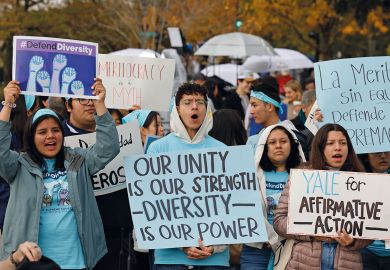US college and universities were showing anaemic growth in racial diversity even before the US Supreme Court ruling last year that rejected overt affirmative action strategies, meaning that the institutions need to look more at themselves for solutions than blame the judiciary, a Georgetown University research team has concluded.
The investigation by the Georgetown University Center on Education and the Workforce reiterates other signs of slow long-term racial progress in US higher education, although it adds to the certainty by compiling a decade of federal data across a wide cross-section of about 500 of the nation’s highest-ranked campuses.
The result, the Georgetown analysts said, points to the need for more emphasis by institutions in areas that include reducing their use of legacy-based preferences, actively recruiting minority and first-generation students, and restoring and refining their use of standardised admissions tests.
Even in the era of legalised racial preferences – before the June 2023 Supreme Court decision in the cases of Harvard University and the University of North Carolina – “we had these huge biases” in college admissions that still left minority students struggling for equal representation, said Jeff Strohl, a research professor of public policy and director of the Georgetown centre.
The Supreme Court decision was widely bemoaned across much of the nation’s higher education establishment. The US secretary of education, Miguel Cardona, said at the time that it “takes our country decades backward, sharply limiting a vital tool that colleges have used to create vibrant, diverse campus communities”.
The Georgetown figures, covering the period of 2009 to 2019, suggest that such impressions may have been overly dramatic. During that 10-year study period, the centre showed, the nation’s white college-age population decreased by 12 per cent but lost no share of its enrolment at selective institutions. The enrolment of black and Hispanic students increased only slightly during that time, the centre said.
The analysis comes as a rising number of prominent US colleges and universities, including Harvard, are resuming their use of standardised tests such as the SAT and ACT in their admissions processes, deciding that a set of tools long derided as reinforcing wealth and privilege might actually help minorities if used carefully.
Georgetown’s data lend support for that perspective, Professor Strohl said. On one level, he said, the centre’s work shows that if selective institutions used a straight SAT-only method of making admissions decisions, about half of their current white students would have fallen below that dividing line and would not have been admitted. Yet the overall result of such a straight-line approach, he said, would be the admission of even more white students.
But if selective institutions admitted a more diverse collection of students who score close to that dividing line, they could enrol far greater numbers of students who bring both racial minority backgrounds and a demonstrated ability to complete their degrees, Professor Strohl said.
And that kind of admissions decision-making would be far more cost-effective for the goals of higher education, he continued, because students of minority backgrounds – especially those whose parents have no college experience – reap far greater benefits than do their classmates from the more intensive atmosphere of student support that wealthier institutions provide.
Part of the problem there, the Georgetown team noted, is that students lacking family experience in higher education too often do not apply to a top-ranked institution, failing to realise that it actually could be more affordable for them than a more middle-of-the-road alternative, because the wealthier campuses offer them more financial aid.
But there are at least two major obstacles to improvements on that front, the Georgetown authors noted, that are not related to the Supreme Court’s decision. One is that many colleges and universities want to choose students with higher SAT scores because it helps the institutions look better on the methodologies used by many rankings publishers. Another hurdle they cited is that the highest-ranked US universities appear to be intentionally limiting their acceptance of lower-income students, as part of their budgetary calculations.
It seems consistent over many years, said Emma Nyhof, a policy analyst at the Georgetown centre, that the most elite US institutions stay below 20 per cent in the share of their admitted students eligible for the federal Pell grant, the main federal subsidy for low-income students. “And the top tier is still around that level of 16 per cent or 17 per cent,” she said.
Register to continue
Why register?
- Registration is free and only takes a moment
- Once registered, you can read 3 articles a month
- Sign up for our newsletter
Subscribe
Or subscribe for unlimited access to:
- Unlimited access to news, views, insights & reviews
- Digital editions
- Digital access to THE’s university and college rankings analysis
Already registered or a current subscriber?








